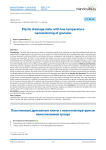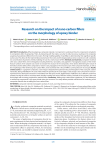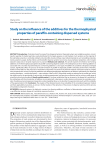Development of new materials. Рубрика в журнале - Nanotechnologies in Construction: A Scientific Internet-Journal

Plastic Drainage Slabs with low-temperature nanosintering of granules
Статья научная
Introduction. Currently, the construction industry is developing rapidly. New residential and industrial buildings and structures appear both in megalopolises and small towns. In this regard, an active development of the underground space continually gains in scope: basements and buried facilities, multistorey structures, underpasses and parking lots, shopping malls and many other structures are being built. In order to create reliable and durable structures much attention should be paid to the protection of underground parts of buildings from the destructive effects of groundwater. Waterproofing and drainage materials currently used do not always meet the necessary requirements. The paper discusses the development of a new material for wall drainage in order to provide reliable protection for underground buildings against the damaging influence of groundwater. Methods and materials. The article presents a detailed analysis of existing methods and materials that are used in the installation of wall drainage systems. Plastic slabs made of filtration expanded polystyrene have been proposed as an effective drainage material. The technology of filtration material with high water transmission capacity is presented. This methodology is based on the low-temperature nanosintering of polystyrene granules. The main structural characteristics of filtration polystyrene, including characteristic pore diameter and intergranular porosity, and its physical and mechanical properties were determined. Results and discussion. The results of research on the structure of filtration expanded polystyrene with different grain-size compositions are given. It is shown that due to the process of nanosintering of granules it is possible to form varies types of drainage slab structures, which are necessary to obtain required characteristics. In addition, the experimental results of the water transmission capacity of drainage slabs, depending on the structural characteristics of the material, are also presented. Based on the tests conducted, an empirical formula has been developed to calculate the filtration coefficient of the plastic drainage slabs. Recommendations have been developed for selecting the grain composition of material when working on cohesive and non-cohesive soils. Conclusion. The results of our study show that filtration expanded polystyrene slabs have a high-water transmission capacity and sufficient compressive strength and can be used to protect the underground parts of buildings based on different soil types.
Бесплатно

Research on the impact of nano carbon fillers on the morphology of epoxy binder
Статья научная
Introduction. When developing a composite material, it is important to understand how the components included in its composition affect its properties. Fillers, by interacting with the matrix, can alter its initial structure, resulting in the composite acquiring characteristics different from the matrix. The high modifying ability of nanofillers is determined by their significant specific surface area. This allows for the total interfacial area between the matrix and the dispersed phase to be covered even with a relatively low concentration of particles, thereby enabling the use of a small amount of filler. Methods and materials. Composite materials with nano carbon fillers were investigated, including fullerenes, nanotubes, and graphene. Fractographic analysis of the tensile fracture surfaces of the samples was chosen to evaluate the structure of the composites, which allows determining the nature of the failure and the ability of the composite to restrain crack propagation. The microstructure of the composite materials, as well as the morphology of the reinforcing nano carbon fillers, were examined with a Tescan MIRA3 scanning electron microscope. Results and discussion. In a graphene composite, crack energy is dissipated through branching and elongation of the crack path. Carbon nanotubes, being embedded in the crack walls, hinder the opening of the crack edges. Crack energy is also consumed in overcoming friction forces during the extraction of nanotubes from the epoxy matrix. Agglomerates of fullerenes act as effective crack front arresters, forcing the crack to circumvent them, thereby creating new areas of fracture surfaces. This leads to an increase in the crack front length and the energy required for material failure. Conclusion. Adding nano-carbon fillers (graphene, CNT and fullerenes) as reinforcing components in the epoxy binder alters the structure. The study defines possible mechanisms for hardening of the composite materials due to adding the nano-carbon fillers.
Бесплатно

Статья научная
Introduction. Particular interest for research has dispersed systems. Dispersed systems are multiphase systems, consisting of a quantity of smallest particles, evenly distributed in the liquid, gaseous or solid medium. Such systems are the majority of the real bodies around us: soil, bodies of plant and animal life, clouds and fogs, many industrial products, such as building materials, metals, polymers, paper, leather, fabrics and foodstuffs. Disperse systems have many unusual physical properties, which require separate study and are of great importance in practice. Methods and materials. This article explores the influence ion-forming additives on the thermophysical properties of paraffin-containing disperse systems. The widespread use of ion-forming additives is associated with a number of positive features. Ion-forming additives is a new type of modifiers of crystalline solid phase and liquid crystals, significantly affect the process of micelle formation of paraffin in dispersed paraffin-containing environment. Therefore, studies on their effect on the processes of nucleation and growth of crystals are of particular interest. During the research, samples were prepared with various ion-forming additives and obtained temperature dependences of dielectric permittivity for dispersed systems petrolatum – methyl ethyl ketone – water solution of NaCl and KCl. Polynomial models are selected as the model type, which are widely used in the processing of various data, including experimental, and are also an effective tool for solving a wide range of scientific and technical problems. Results and discussion. It has been established that an increase in the degree of crystallinity of the solid phase with the introduction of additives is associated with a decrease in surface tension and increase in secondary nucleation. Resulting universal regression dependence of permeability allows us to describe the experimental results with the reliability of the approximation 0.99. Conclusion. The analysis of the obtained results shows reliability of the considered regression models and their applicability in practice, as well as in further studies of the dynamics of the process in disperse systems and the process of nucleation and growth of crystals.
Бесплатно

